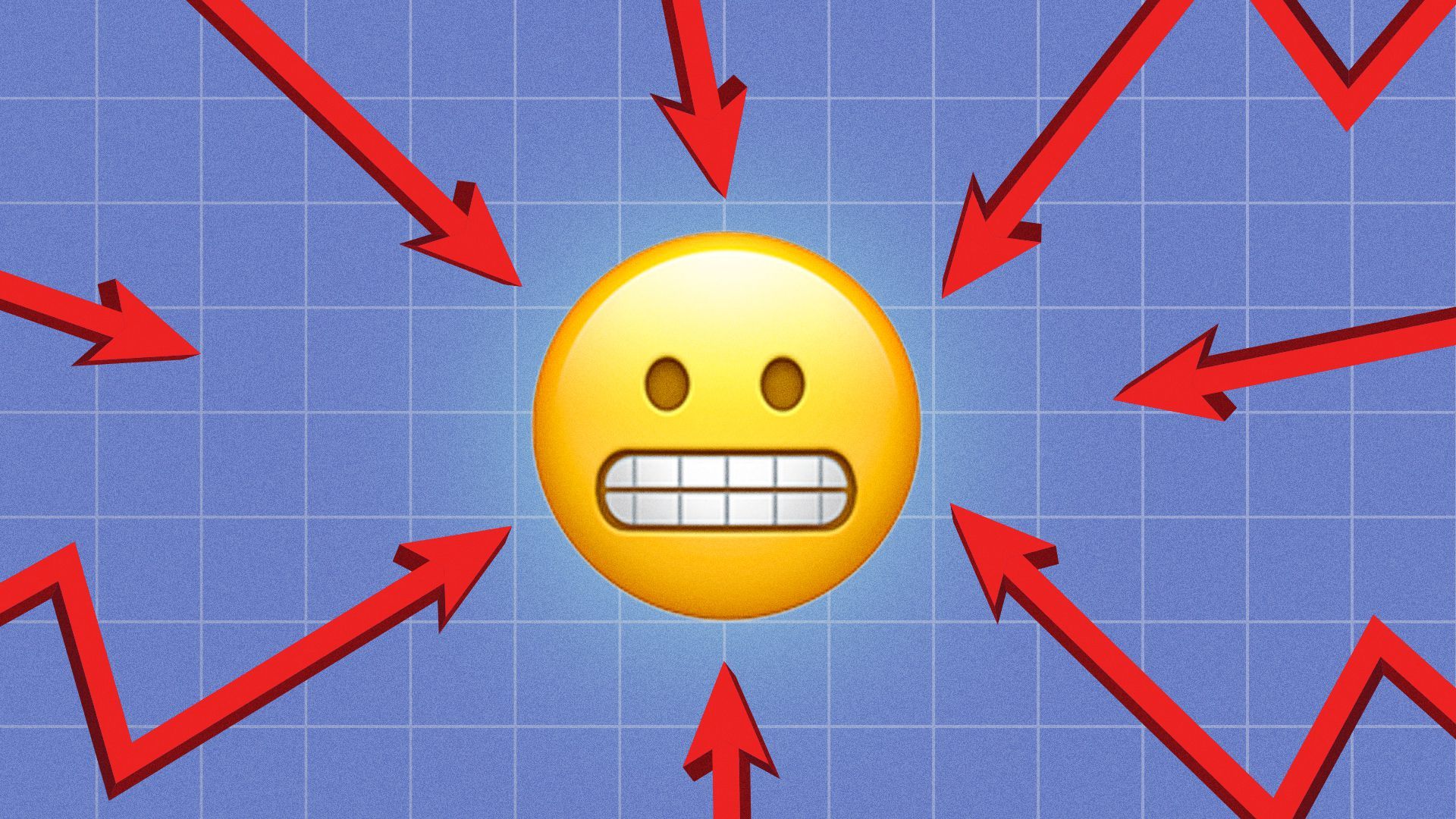| | | | | | | | | | | Axios Markets | | By Emily Peck and Matt Phillips · Apr 29, 2022 | | 🎉 It's Friday! Today's newsletter, edited by Kate Marino, is 1,027 words, 4 minutes. And, chicken wing prices are moderating. We must go out this weekend and shake off our bad mood because... | | | | | | 1 big thing: Bad vibes are having a moment |  | | | Illustration: Aïda Amer/Axios | | | | One of the persistent storylines of the last six months or so is the clash between Americans feeling pessimistic about the economy and the reality of the actual (booming) economy. But that tale may be about to enter a new chapter, Emily writes. The big picture: We're at a pivot point in this bad vibe era as the Federal Reserve moves to for-real put the brakes on the economy — which could cool off the era's signature hot labor market. Next week the Fed will likely hike rates by a half-percentage point. Between the lines: U.S. GDP figures out Thursday played into the bad mood, as the first quarter came in weaker than expected — with negative headline growth for the first time since 2020. - But under the hood, the report wasn't so bad. GDP arithmetic means that soaring imports — which reflect strong domestic demand — combined with falling exports shaved more than three points off the quarter's growth, as Axios' Neil Irwin reported.
State of play: Regardless of a hot labor market, day-to-day things are, uh, less than awesome for a lot of people — from the ongoing pandemic weirdnesses to the shock of gas prices. It's not surprising that bad feelings are in the air. - "Consumers are increasingly feeling the pinch from high prices, of food, energy and rents, among other things," Rubeela Farooqi, chief U.S. economist at High Frequency Economics told Axios in an email. "But they have managed to spend, supported by gains in incomes and savings."
- Though, people do keep spending, as our friends at Closer wrote yesterday. It's unclear how much longer they can keep that up.
The intrigue: The hot labor market is the clear bright spot in the economy, with very low unemployment, and record job security. There are some signs it's cooling a bit, says Nick Bunker, economic research director at the Indeed Hiring Lab. - "But that's moving from a labor market that was at 105 degrees to a market that's maybe 95 degrees. Still hot."
Yes, but: Jobs aren't everything. Americans have a lot of worries on their minds — inflation, spillover from the war in Ukraine, and continued supply chain snarls. The bottom line: All of these worries take a toll; Americans' mental health issues have certainly worsened over the past two years. - "People make complex economic decisions that aren't just responding to one fact in their economic life," says Richard Curtin, director of the University of Michigan's surveys of consumer sentiment. "These concerns invariably have a negative impact on the economy, if they occur."
Go deeper. |     | | | | | | 2. Catch up quick | | 📈 Top China leaders vow to boost stimulus and support tech companies, sparking gains in Chinese stocks. (Bloomberg) 🛢 Germany drops opposition to buying Russian oil, clearing the way for EU ban. (WSJ) 💰 Elon Musk sold roughly $4 billion of Tesla shares. (CNBC) 📲 Apple forecasts up to $8 billion hit from supply chain issues. (FT) |     | | | | | | 3. We're still not in a recession |  Data: BEA; Chart: Jacque Schrag/Axios The advance first-quarter GDP figure came in at a shockingly low -1.4%, Axios' Felix Salmon writes. The big picture: It's still pretty safe to say that we're not in a recession, even if it's less safe than it was a couple of weeks ago. For one thing, the advance GDP report generally gets revised substantially. But more importantly, the core drivers of the economy remain strong. State of play: "Final domestic demand" is what you get when you look at the American economy itself, stripping out trade and inventories. - By that measure: GDP is actually rising. The Q1 report had it going up at a 3.7% annual pace.
The bottom line: As Axios' Neil Irwin says, "Underlying growth remains relatively strong, for now." |     | | | | | | A message from Axios | | Break through the clutter | | |  | | | | Brands have stories to tell, but they often struggle to grab leaders' attention. Okay, but: Axios' Smart Brevity Studio cracked the code for high-performing branded content that is newsy, relevant and audience-first. Request more info. | | | | | | 4. Charted: America's at-home economics |  Data: U.S. Bureau of Economic Analysis; Chart: Thomas Oide/Axios Details from yesterday's first-quarter GDP report show a snapshot of how the world has changed over the last few years, Matt writes. Why it matters: The COVID-era focus on home-buying, home optimization and remodeling is an example of the remarkable changes that occurred in the American economy and individual behavior over the last couple of years. State of play: Residential fixed investment activity — a category of the GDP report that includes everything from constructing new homes and apartment buildings to remodeling and alterations — surged in the aftermath of COVID and has remained above pre-pandemic levels. - In contrast, recreation services activity — which encompasses gambling, museums and movies, among other activities — plummeted at the onset of the pandemic and still hasn't completely recovered.
What we're watching: How long it takes for the flurry of investment in housing to die down in the face of sharply higher mortgage rates. |     | | |  | | | | If you like this newsletter, your friends may, too! Refer your friends and get free Axios swag when they sign up. | | | | | | | | 5. The dollar just hit a 20-year high against the yen | | Data: FactSet; Chart: Axios Visuals The greenback soared on Thursday. It will now buy more than 130 yen — a level not seen since mid-2002 — in an illustration of the dollar's growing muscle, Matt writes. Driving the news: The surge against the yen came after the Bank of Japan stuck to plans to keep interest rates low, despite an increasingly inflationary global backdrop. Yes, but: Japan, with its decadeslong battle with deflation and rapidly aging demographics, has seen much more muted price increases than the rest of the world. - In fact, its latest inflation report showed just a 1.2% rise in annual inflation, still far below the Bank of Japan's elusive goal of 2%.
How it works: Currency values are sensitive to the discrepancies between the central bank interest rate moves in different countries. All else equal, if a central bank is boosting rates — as the Fed is — those higher rates attract capital from countries like Japan where interest rates look likely to stay low. - Those dynamics have pushed the dollar up and the yen down sharply in recent months.
The intrigue: The Bank of Japan seems to believe the weak yen will be a boon to the country's powerful export sector. - But with fuel costs soaring — Japan is a massive energy importer — it also can be costly for consumers and politically sensitive. And if supply chain snarls are hampering exports, a weak yen won't do much to set off a boom in sales.
What we're watching: Japanese export data, which has been on a roll recently, though not enough to offset the surging cost of energy imports. |     | | | | | | A message from Axios | | Break through the clutter | | |  | | | | Brands have stories to tell, but they often struggle to grab leaders' attention. Okay, but: Axios' Smart Brevity Studio cracked the code for high-performing branded content that is newsy, relevant and audience-first. Request more info. | | |  | It's called Smart Brevity®. Over 200 orgs use it — in a tool called Axios HQ — to drive productivity with clearer workplace communications. | | | | | | Axios thanks our partners for supporting our newsletters. If you're interested in advertising, learn more here.
Sponsorship has no influence on editorial content. Axios, 3100 Clarendon Blvd, Suite 1300, Arlington VA 22201 | | | You received this email because you signed up for newsletters from Axios.
Change your preferences or unsubscribe here. | | | Was this email forwarded to you?
Sign up now to get Axios in your inbox. | | | | Follow Axios on social media:    | | | | | |












No comments:
Post a Comment